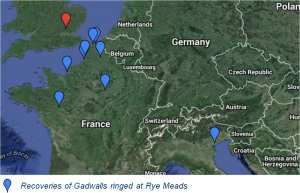Results


Contrasting migration strategies of Teal and Gadwall
Two of the ducks that are commonest at Rye Meads in their season are Teal and Gadwall.
Teal are winter visitors, and do not breed at Rye Meads. However, there are often only a matter of weeks between the last winter visitors leaving and the first of the “Autumn” returning (often by the end of June or early July), presumably failed breeders.
In fact, Teal breed across northern Eurasia from Scotland to Siberia, and these birds move west and south for the winter, with some coming to Rye Meads, as the map of RMRG recoveries demonstrates very well.


By contrast, Gadwalls do breed at Rye Meads – for example, in 2015 there were at least 18 broods of a minimum of 103 ducklings hatched (actually a relatively poor season) – and also quite widely throughout Europe and across Asia north of the Himalayas. Gadwalls are present all year round; however, many of our breeding birds leave us for the winter, and others move in from more northerly regions – winter duck counts for the WeBS survey regularly exceed 200 and can reach 400 in wintry weather.
It seems that our birds tend to move south and east into Europe for the winter, but at present there is relatively little evidence of more northerly and easterly Gadwalls coming our way for the winter.
We look forward to further recoveries of both of these very appealing ducks to add to our knowledge of the birds that pass through Rye Meads.
